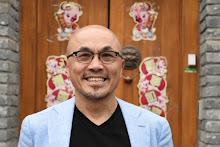March 20, 2008
Today I decided to take a second trip to the Chinese Military History Museum (or more accurately, the Military Affairs Museum of the Chinese People's Revolution) which is located on the western side of Beijing. I wanted to refresh my memory about the exhibits and take a few more pictures for this blog (see my Flickr site for all the pictures).
To get to the subway, I had to take a taxi from my house. On the way down, I got into an interesting conversation with my driver who asked me what I thought about the recent protests (or riots depending on which perspective you’re taking) in Tibet. I said I didn’t trust the Chinese government’s reports and wish I had more information about what was going on. I didn’t doubt that there was violence on both sides, but said the government had all the firepower and should be careful how they handled these protests. Being a good Chinese citizen, he tried to defend the government’s actions. He said, the Tibetans were causing a lot of disorder, burning and looting. I went back to my point about the Chinese government’s lack of credibility, especially in the eyes of the international community, but I don’t think I persuaded him. Before we could get any further in our discussion, I was at the subway station.

The Military History Museum looks from the outside like a piece of Soviet-inspired architecture and inside it’s appropriately dim and dreary until you get to the exhibits. Today, entrance was free and there were crowds of schoolchildren traipsing past the exhibits.

The purpose of this museum is pretty clear, at least to an American who is cynical about these kinds of things, and that is to instill pride in the People’s Liberation Army (PLA), Chinese Communist Party (CCP), and China in general. The third floor which is about the People’s Liberation Army today is one big propaganda ad, full of glowing, colorful displays of shiny weaponry and smiling soldiers and politicians contributing to China’s development. Perhaps it’s appropriate that the gift shop is located on that floor! After leaving that exhibit, who wouldn’t want to buy a medal with Mao’s picture on it, or a shiny tank made out of bullet casings!

The first two floors, which is where I spent most of my time, is more interesting. The display, particularly the socialist realist artwork, are still meant to instill nationalist pride (as you can see from the pictures) but there is more attention to history in the form of photos, documents and other artifacts. The first floor tells the story of how the CCP and the PLA developed after the split between the CCP and KMT in 1927 up to the Japanese invasion of China in 1937. The second floor continues the story of China’s (meaning the CCP’s!) resistance against the Japanese, and the civil war between the CCP and KMT that ends with the CCP’s victory in 1949.
There are several things I took away from this visit:
One is that the displays drive home the fact that the CCP and the PLA developed hand in hand. The party and the army, politics and the military, were one (and you could say the same about the KMT). All the important CCP leaders after 1949 had their formative experience in the PLA. Conversely, the PLA was not just a military machine. It played an important role in the CCP’s ideological and social campaigns to recruit support from the peasantry. This close relationship between the party and army is still important to understanding the CCP today.
Second, the exhibit gives you an appreciation for how long, arduous and precarious the process of building an organization like the CCP was. When the CCP began to strike out on its own in 1927, it’s survival was by no means guaranteed. There was infighting among its own members (something only hinted at in the displays), attempts by the KMT to eliminate the CCP, the Long March which decimated the Communist forces, the Japanese invasion, and then the KMT again. One nightmare after another. Yet the CCP was able to overcome all these obstacles and grow stronger in the process. Even for hardened cynics like myself, the displays do inspire admiration for what CCP leaders were able to accomplish in the face of incredible odds. I can only imagine what the Chinese feel after leaving the museum.
Third, keep in mind that this is a military museum and thus it leaves out much of the social and cultural changes taking place during this very turbulent period. As I said earlier, the PLA (or Worker and Peasant Red Army as it was initially called) was as much a military force as it was an organization for carrying out the ideological and socioeconomic experiments of the CCP in the countryside. In this sense, the CCP was built to “win the hearts and minds” of the peasantry and did so much more successfully than the U.S. troops ever were able to do in Iraq.




1 comment:
Shawn,
I am ashamed to say that after a year in China/Beijing, I have yet to visit the military museum. From your posting it seems that the exhibits there offer a useful visual presentation of the rise of the CCP. Would you recommend it as a place to take American college students on this topic?
Post a Comment